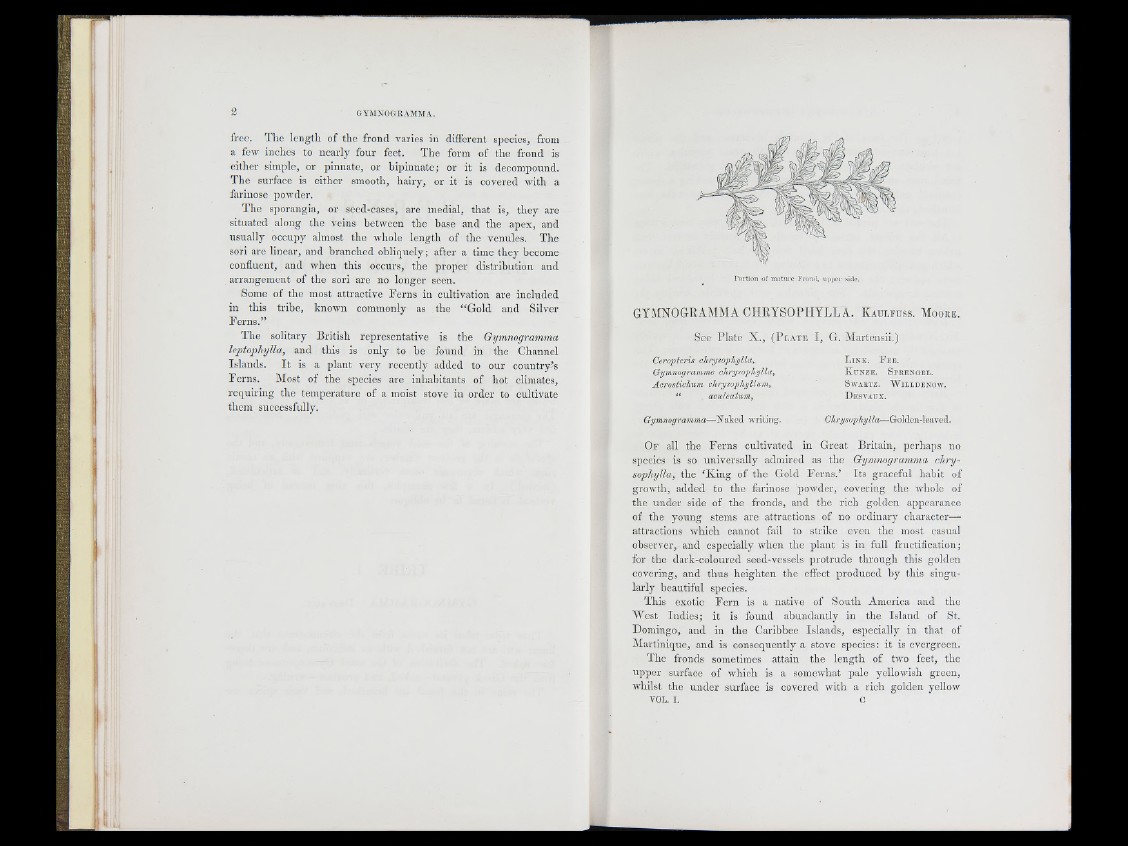
free. The length of the frond varies in different species, from
a few inches to nearly four feet. The form of the frond is
cither simple, or pinnate, or bipinnatc; or it is decompound.
The surface is either smooth, h airy, or it is covered with a
farinose powder.
The sporangia, or sced-cases, are medial, th a t is, they are
situated along the veins between the base and the apex, and
usually occupy almost the whole length of the venules. The
sori are linear, and branched obliquely; after a time they become
confluent, and when this occurs, the proper distribution and
arrangement of the sori are no longer seen.
Some of the most attractive F erns in cultivation are included
in this tribe , known commonly as the “ Gold and Silver
F e rn s.”
The solitary British representative is the Gymnogramma
leptophylla, and this is only to be found in the Channel
Islands. I t is a plant very recently added to our country’s
Ferns. Most of the species are inhabitants of hot climates,
req u irin g the temperature of a moist stove in order to cultivate
them successfully.
Portion of mature I'roml, upjier side.
G YM NOGRAM MA C H R Y S O P I IY L L A . K a u l f u s s . M o o r e .
See Plate X ., ( P late I , G. Martensii.)
Ceropteris clirysopliylla,
Gymnogranime clirysopliylla,
Acrosticlium clirysopliyllum,
“ aculeaium,
Gymnogramma—Naked writing.
I j i s k . F e e .
K u k z e . S p r e n g e l .
S w a r t z . W i l l d e n o w .
D e s v a u x .
Chrysophylla—Golden-leaved.
O f all the Ferns cultivated in Great Britain, perhaps no
species is so universally admired as the Gymnogramma chrysophylla,
the ‘K in g of the Gold F e rn s.’ Its graceful habit of
growth, added to the farinose powder, covering the whole of
the under side of the fronds, and the rich golden appearance
of the young stems are attractions of no ordinary character—■
attractions which cannot fail to strike even the most casual
observer, and especially when the plant is in full fructification;
for the dark-coloured seed-vessels p rotrude thro u g h this golden
covering, and thus heighten the effect produced by this singularly
beautiful species.
This exotic F e rn is a native of South America and the
West Ind ie s; it is found abundantly in the Islan d of St.
Domingo, and in the Caribbee Islands, especially in that of
Martinique, and is consequently a stove species: it is evergreen.
The fronds sometimes attain the length of two feet, the
upper surface of which is a somewhat pale yellowish green,
whilst the u n d e r surface is covered with a rich golden yellow
VOL. I. c